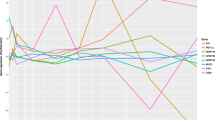Abstract
The reverse construction and analysis of the networks of molecular interactions are essential for understanding their functions within cells. In this paper, a logic network model is constructed to investigate the complicated regulation mechanism of shoot genes of Arabidopsis Thaliana in response to stimuli. The dynamics of the complicated logic network is analyzed, discussed, and simulated. The simulation results show that the logic network of the active genes of shoot eventually evolves into eleven attractors under the stimuli, including five 1-periodic and six 2-periodic attractors. Our work provides valuable reference and guidance for biologists to understand and explain Arabidopsis’ response to external stimuli by experiments.
Similar content being viewed by others
References
E. M. Marcotte, M. Pellegrini, H. L. Ng, et al., Detecting protein function and protein-protein interactions from genome sequences, Science, 1999, 285: 751–753.
M. Strong, T. G. Graeber, M. Beeby, et al., Visualization and interpretation of protein networks in Mycobacterium tuberculosis based on hierarchical clustering of genome-wide functional linkage maps, Nucleic Acids Res., 2003, 31: 7099–7109.
X. Zhou, M. C. Kao, and W. H. Wong, Transitive functional annotation by shortest-path analysis of gene expression data, Proc. Natl. Acad. Sci., 2002, 102(38): 12783–12788.
P. M. Bowers, S. J. Cokus, D. Eisenberg, and T. O. Yeates, Use of logic relationships to decipher protein network organization, Science, 2004, 306(5705): 2246–2249.
P. M. Bowers, B. D. O’Connor, S. J. Cokus, et al., Utilizing logical relationships in genomic data to decipher cellular processes, The FEBS Journal, 2005, 272(20): 5110–5118.
X. Zhang, S. C. Kim, T. Wang, and C. Baral, Joint learning of logic relationships for studying protein function using phylogenetic profiles and the Rosetta Stone method, IEEE Transactions on Signal Processing, 2006, 54(6): 2427–2435.
J. X. Zhang, Y. Ji, and L. Zhang, Extracting three-way gene interactions from microarray data, Bioinformatics, 2007, 23(21): 2903–2909.
S. A. Kauffman, The Origins of Order: Self-organization and Selection in Evolution, Oxford University Press, Oxford, 1993.
I. Shmulevich, S. A. Kauffman, and M. Aldana, Eukaryotic cells are dynamically ordered or critical but not chaotic, Proc. Natl. Acad. Sci., 2005, 102(38): 13439–13444.
F. Li, T. Long, Y. Lu, Q. Ouyang, and C. Tang, The yeast cell-cycle network is robustly designed, Proc. Natl. Acad. Sci., 2004, 101(14): 4781–4786.
N. M. Luscombe, M. M. Badu, H. Yu, et al., Genomic analysis of regulatory network dynamics reveals large topological changes, Nature, 2004, 431: 308–312.
Z. Y. Fu, Information Theory-Elements and Application, Press of Electronics Industry, Beijing, 2004, 2.
X. F. Wang, X. Li, and G. R. Chen, The Theory and Application of Complex Networks, Tsinghua University Press, Beijing, 2006, 4.
Q. Y. Wang, H. Yi, L. F. Liu, and D. Z. Meng, Progress in gene logic networks, Progress in Biochemistry and Biophysics, 2008, 35(11): 1239–1246.
Author information
Authors and Affiliations
Corresponding author
Additional information
This research is supported by the National Natural Science Foundation of China under Grant Nos. 60874036 and 60503002.
Rights and permissions
About this article
Cite this article
Wang, S., Chen, Y., Wang, Q. et al. Analysis for gene networks based on logic relationships. J Syst Sci Complex 23, 999–1011 (2010). https://doi.org/10.1007/s11424-010-0205-0
Received:
Revised:
Published:
Issue Date:
DOI: https://doi.org/10.1007/s11424-010-0205-0




